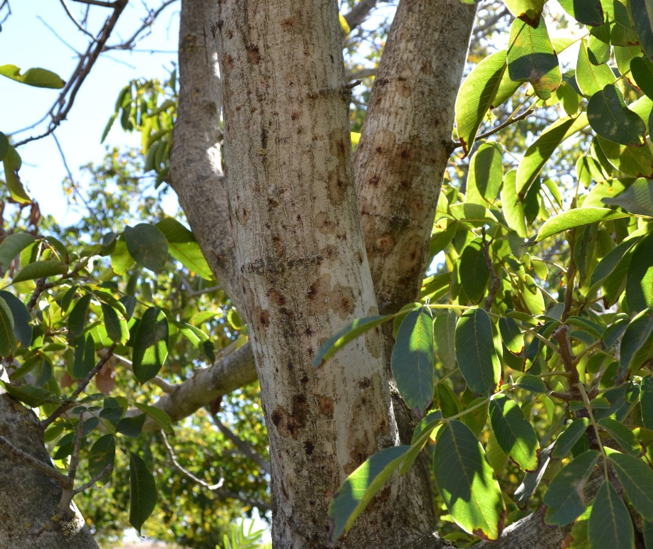The walnut tree (Juglans sp.) is well known for its valuable wood and timber quality and its nutritious nut. Different native species of walnut are an important part of the ecological system in North America. Eastern black walnut (Juglans nigra) is native to eastern North America from the northeast in Vermont and southern Ontario to Minnesota and south to Florida. It also ranges east from the Atlantic coast to central Texas except the Mississippi River Valley and Delta. Juglans nigra has an important economic value estimated at more than $500 billion for its wood and timber alone. Among the other species that are considered native to the US with natural range are Arizona walnut (Juglans major), Texas walnut (Juglans microcarpa), and California black walnuts (Juglans californica and Juglans hindsii).
In California, there are two native ranges of California back walnut species; Southern California black walnut (J. californica) and Northern California black walnut (J. hindsii). Beside their importance in the ecological system as a source for food and shelter for wildlife, J. hindsii has an economic value for its wood, and as a rootstock for English walnuts (J. regia) in commercial orchards or as a parent in the hybrid rootstock ‘Paradox’ (J. hindsii × J. regia).
California is also considered the number one state for producing English walnuts with approximately 99 percent of the total U.S. production. English walnut, which is native to Asia and was first introduced to California later in the eighteenth century with the first commercial orchard planted in 1843. Walnut is a high value crop and considered one of the major nut crops grown in California and ranks in the top ten commodities in California with approximately 300 thousand acres and a market a value of approximately $977 million in 2015.
In early 1990’s, black walnut decline and mortality was observed in Utah and Oregon and was not associated to any biotic cause at the time. It was not until later in 1997 and 2001 that black walnut mortality in Utah, Oregon, and New Mexico, and somewhat later in Colorado, was associated with walnut twig beetle (WTB) Pityophthorus juglandis. However, it was not until 2008 that tree mortality was attributed to WTB feeding in the phloem, and to canker formation around the WTB galleries caused by a new fungus. The fungus was later described as Geosmithia morbida and the disease was called Thousand Cankers Disease (TCD). The name was proposed due to the many cankers developed around beetles’ galleries that coalesce and girdle twigs and branches resulting in decline and mortality.
Currently, TCD is considered a complex and emerging disease in the US and California, and it is responsible for decline, dieback, and death of eastern black walnut in western US, and is currently spreading in the native range of the eastern black walnut. It is also widespread in California causing decline in California black walnuts and disease in English walnut orchards. Beside its spread in the US, it was reported in Italy on eastern black walnut and English walnut trees and vectored by the WTB.
Any plant fungal disease is a function of three major factors, the pathogen, a susceptible host, and environmental conditions conducive to disease development. In this case, the pathogen is being vectored by an insect making the insect an important part of disease development. Thus, an understanding of the biology of the insect, the fungus, host susceptibility and their interaction is necessary to understand the disease biology and development, and thus help in developing effective control methods. In this article, we will introduce the signs and symptoms of this disease as well the different factors contributing to its development, and how the current advances may help control this disease.
Signs and Symptoms
Affected walnut trees will show symptom of branch die back and flagging (Figure 1). Once we see those symptoms, it is always advised to examine the tree and take a closer look at the bark surface of twigs and the main trunk for signs of entry/exist holes created by the beetle. These will be tiny holes with a size less than 0.04 inch in diameter (Figure 2). The beetle prefers to attack branches that are greater than ½ – ¾ of an inch in diameter. In many cases, affected trees exhibit bleeding around beetle holes, and removal of the surface bark will show cankers development around beetle galleries in the phloem tissue, with sometimes presence of the beetles in the galleries, or signs of fungal mycelium and spores that could be visible in the galleries (Figure 3). As the cankers increase in size, they may coalesce girdling branches and causing tree decline and mortality under severe infections and beetle colonization.
The Beetle
The WTB is very small and it’s approximately 0.06 inch in length (Figure 4). The beetles and the larvae overwinter in the host tissue and emerge between January and March in California. Once they emerge, male WTB looks for a susceptible host and starts to colonize the tree first by initiating new galleries in the twigs or the main trunk. During this process, they produce an aggregate pheromone to attract two to three females for mating. The females lay the eggs in galleries in the phloem and xylem surfaces, and once the eggs hatch, the larvae start to feed and create feeding tunnels along the wood grain. After that, the larvae pupate and emerge as adults and move to colonize the same tree or move to a different tree.
Entomologists at UC Davis and the US Forest Service identified the aggregate pheromone which was a tremendous help in studying the beetle’s biology and behavior. They found that the beetle generally has two flights during the season after their initial emergence between January and March. The primary flight is between May and July; and a secondary flight from September to October. The importance of these studies is that now we have a better idea about WTB seasonal flights and biology allowing us to monitor the WTB using the pheromone and possible future use to enhance IPM programs to control this pest such as the use of mating disruptions techniques. Excellent detailed information about monitoring guidelines for the WTB as well detecting and identifying the beetle can be found in this UCIPM publication. http://entomology.ucdavis.edu/files/194027.pdf
Host susceptibility
The most susceptible host to TCD is eastern black walnut. In field inoculation and greenhouse studies, Juglans spp. showed variable susceptibility to TCD. In California field inoculation studies comparing susceptibility of seven Juglans spp, English walnut and northern California black walnut developed intermediate cankers compared to other species tested in this experiment. Also, Chinese wingnut (Pterocarya stenoptra); a member of the Juglandaceae family; was found to be a host to WTB and susceptible to TCD in California. In the past, Chinese wingnut was evaluated in breeding programs as a potential parent for hybrid rootstocks for English walnut in California. Hence, this work provides valuable information for future rootstock breeding programs.
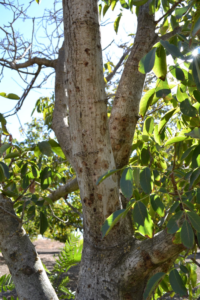
Figure 1. English walnut (Juglans regia) infested with WTB and severely affected by TCD. Symptoms of branch dieback, bleeding at emergence/entry holes. (Photo credit: M. Yaghmour)
During 2012 and 2013, extensive surveys took place in major English walnut producing counties in California to look at the incidence of the disease. What we found is that TCD is more prevalent in the southern San Joaquin valley (Tulare and Kings Counties), then in the Sacramento Valley area (Yuba, Sutter, Solano, Yolo Counties). Additionally, other field observations suggest that trees infected with Agrobacterium tumefacians, the cause of crown gall, may be more susceptible to WTB attack, making them more likely to develop TCD in addition to crown gall. Further research is needed to fully characterize the potential relationship between the two diseases.
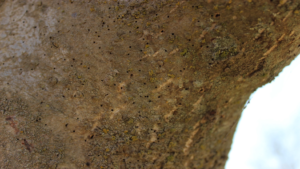
Figure 2. Entry and exit holes created by the walnut twig beetle (Pityophthorus juglandis) on English walnut. (Photo credit: Elizabeth Fichtner)
Control
Currently, use of pesticides as a control method is not available for management of this disease. However, exclusion as a management practice is an important strategy, and this can be achieved using quarantine. Many states established quarantine areas to prevent TCD spread into new areas where TCD was not reported, previously, on eastern black walnut. Keeping TCD from spreading can be achieved by preventing the movement of unprocessed wood as well as firewood. In California English walnut orchards, growers are advised to monitor closely newly and mildly infected trees, and remove and burn or chip trees when they are severely infected and showing sever decline.
It is always important to remember that TCD is a complex disease, and beetle feeding and reproducing behavior by itself does little to tree health. It is the fungus that hitch-hikes on the beetle that is causing the damage. The tremendous advancements accomplished in understanding beetle, and fungus biology, their interaction with the host, as well as current ongoing research to understand volatile organic compounds that repel or attract the beetle, and selecting walnut rootstocks resistant to plant diseases including TCD will all help combat TCD in English walnut orchards. More information about the disease and the beetle can be found under UC IPM Exotic and Invasive Pests page ‘http://ipm.ucanr.edu/EXOTIC/index.html’.
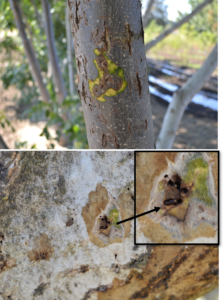
Figure 3. Signs and symptoms of thousand cankers disease. (A) Peeling the bark from a Paradox branch reveals canker development around beetles’ galleries. (B) Beetle boring into the phloem of an English walnut tree.
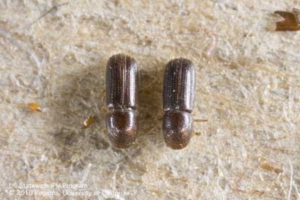
Figure 4. Walnut twig beetle (Pityophthorus juglandis). Approximately 0.06 inches long (Photo credit: L. L. Strand. Source: http://ipm.ucanr.edu/EXOTIC/thousandcankers.html)
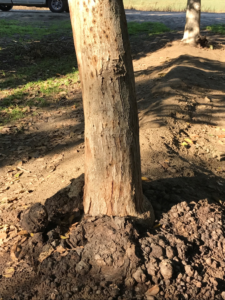
Figure 5. English walnut tree with visible crown gall caused by Agrobacterium tumefaciens with many walnut twig beetle emergence/entry holes on the trunk with visible bleeding around the tiny holes. (Photo credit: Elizabeth Fichtner and M. Yaghmour)


